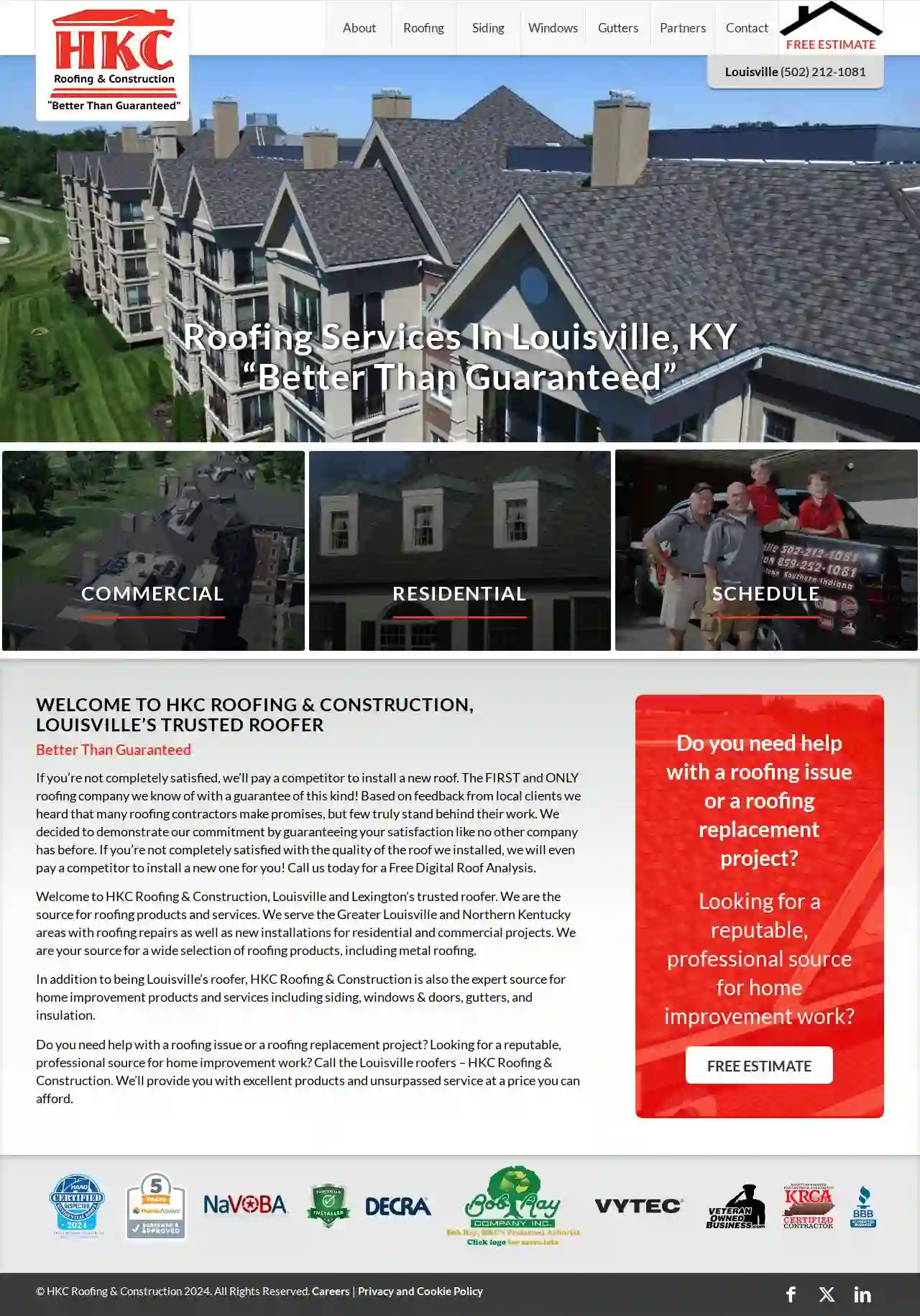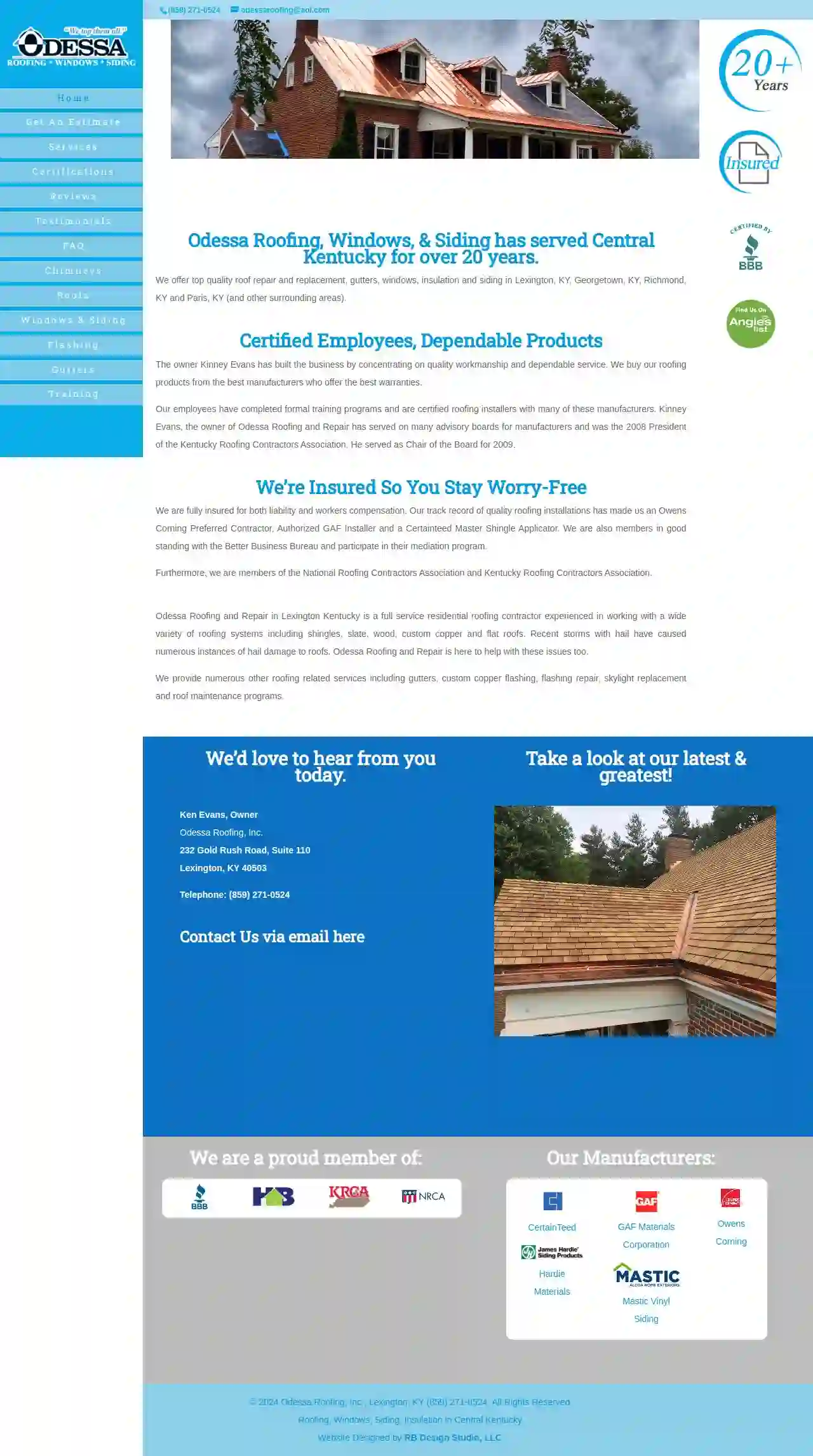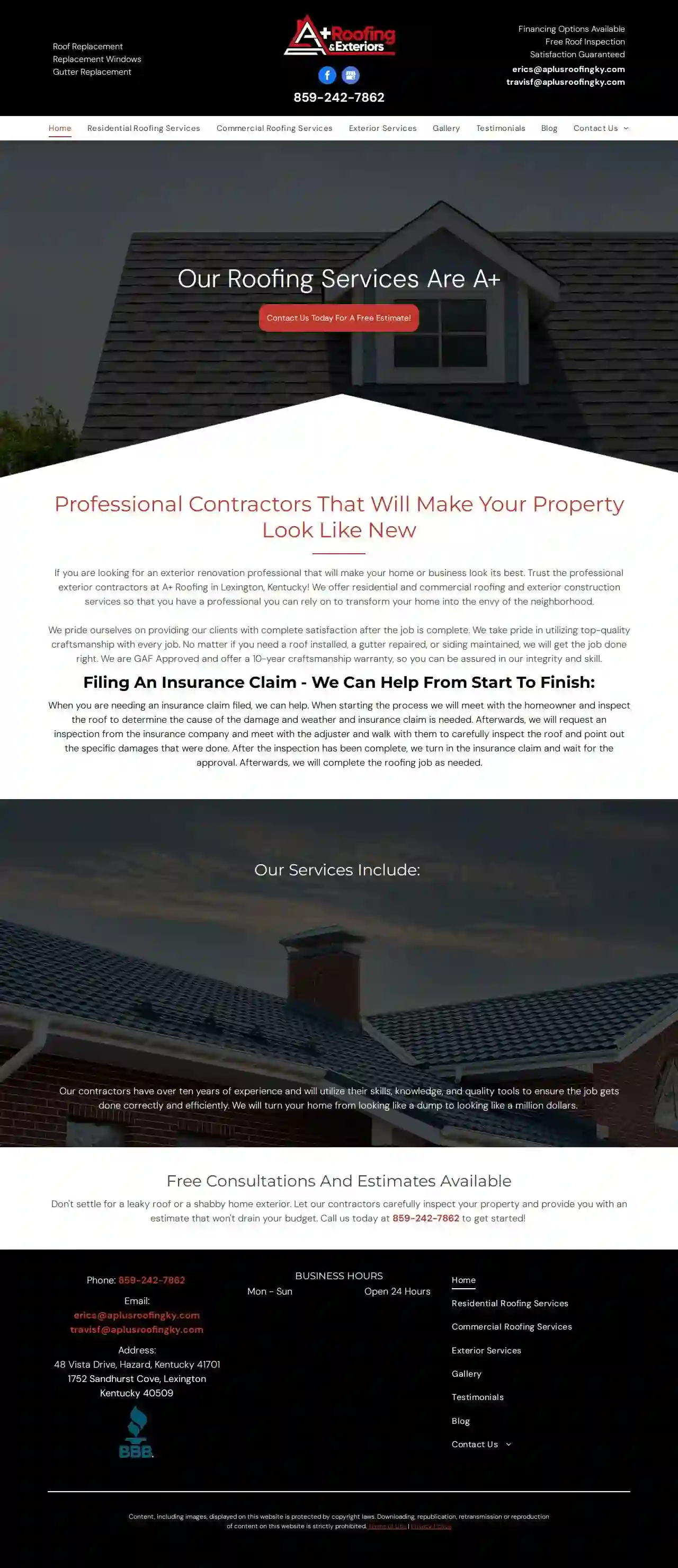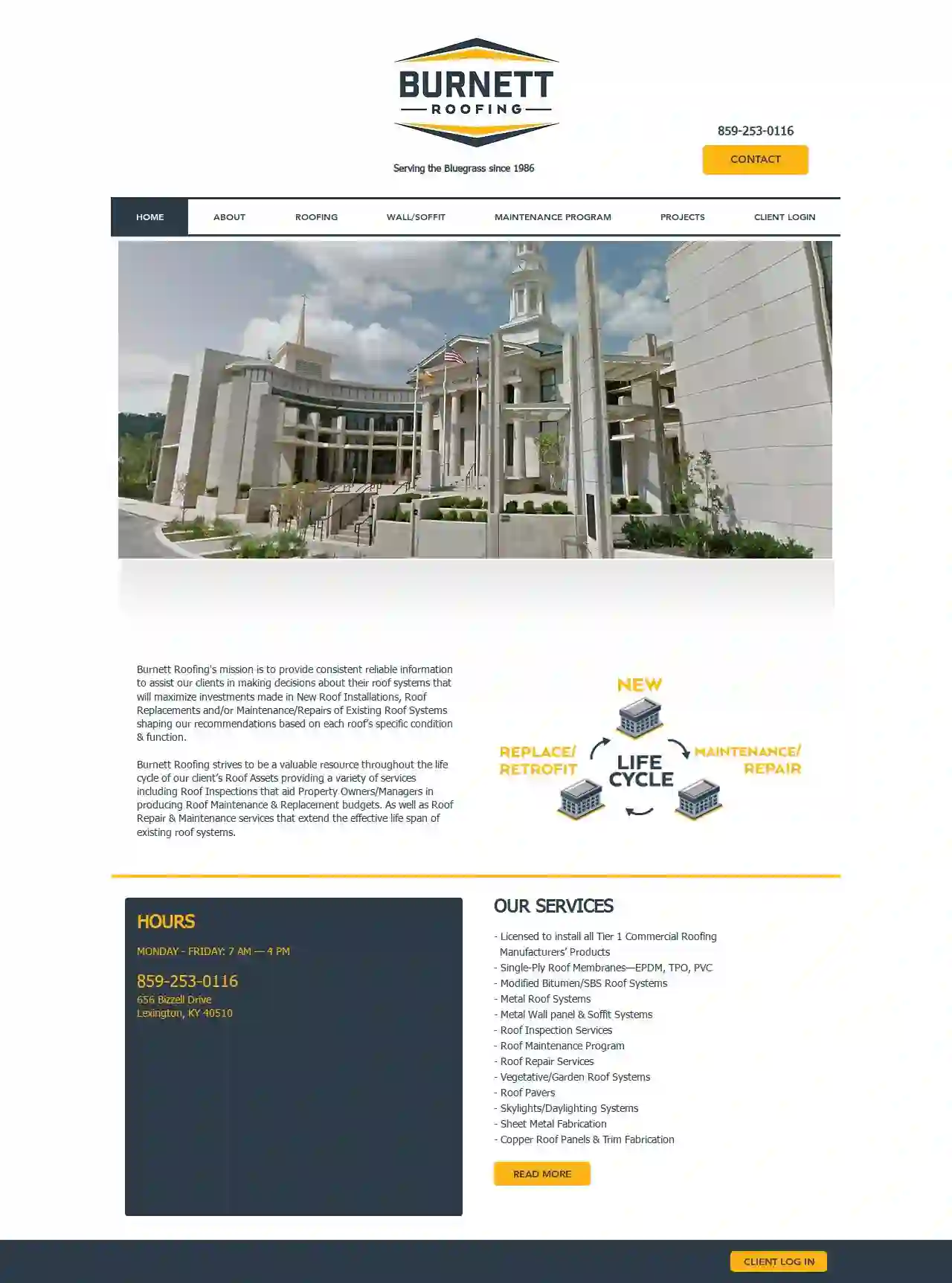Roofing Companies Lebanon
Find top Roofing Company in Lebanon
Receive 3 FREE Roofing Services quotes for your project today! Compare profiles, reviews, accreditations, portfolio, etc... and choose the best deal.

A+ Roofing Solutions Lexington
123 Main St, Lexington, 40503, USAt Roofers Lexington KY, we pride ourselves on being a locally owned and operated roofing company. With over 15 years of experience, we have the expertise and knowledge to handle any roofing project, from residential to commercial. Our team of skilled professionals is dedicated to providing top-notch service and ensuring that our customers are completely satisfied with their roofing experience. We are fully accredited and insured, and we offer a wide range of services, including roof inspections, repairs, replacements, and installations. Whether you need a new roof or just a simple repair, we are here to help. Contact us today to schedule your appointment and let us show you why we are the best roofing company in Lexington, KY.
- Services
- Why Us?
- Accreditations
- Our Team
- Testimonials
Get Quote
A Godsend Roofing LLC
4.9211 reviews251 Price Rd, Lexington, 40511, USA Godsend Roofing LLC is a comprehensive residential and commercial roofing solutions provider in Lexington, KY. With over 30 years of experience, our team of seasoned roofing technicians offers the best in value and work quality for your home, office building, hospital, or apartment complex. We build strong, watertight roofs with a range of limited lifetime warranties. Our services include roof installation, repair, and maintenance, as well as storm damage repair and roof insurance claims help. We're the preferred residential and commercial roofing contractor for property owners in greater Lexington, KY, and we're committed to providing quality services and professionalism. Contact us today at 859-432-7663 to schedule an appointment or learn more about why A Godsend Roofing LLC is Lexington, KY's most trusted roofing contractor and Master Applicator of Owens Corning asphalt shingle.
- Services
- Why Us?
- Accreditations
- Gallery
Get Quote
Big League Roofers
4.881 reviewsLexington, USWelcome to Big League Roofers, Lexington Kentucky's Best Roofing Company. If you're looking for the best roofing company in Lexington Kentucky, then look no further than Big League Roofers. With over 20-years of experience, Big League Roofers specializes in attractive, well-built roofing services for homes and businesses in Lexington, Kentucky. Our family-owned roofing company is here to help you 24/7 with any residential or commercial roof repair or new roof construction. We can assist you every step of the way in working through the insurance claim process in order to expedite your roof repair. Our roofing company is fully licensed & insured, and hold industry certifications from HAAG, GAF, and Owens Corning professional roofers, including having earned Master Elite® Contractor status with GAF, America's #1 roofing supply manufacturer. Master Elite® Contractor status is offered to less than 2% of roofing contractors in North America. Those who have earned this designation have exhibited an uncompromising commitment to the highest standards in sales, service, and installation, and have pledged to ensure that each customer receives the best choice in roofing. Call us today, and we'll be there tomorrow to perform a free, certified, roofing inspection on your residential or commercial property. The Big League guarantee means that we stand behind our roofing work and we are confident in knowing that you will absolutely love your new roof installation. We truly believe that we are the best roofers in the business and stand behind everything that we do!
- Services
- Why Us?
- Accreditations
- Our Team
- Testimonials
- Gallery
Get Quote
HKC Roofing & Construction
4.25 reviewsLexington, USWelcome to HKC Roofing & Construction, Louisville and Lexington’s trusted roofer. We are the source for roofing products and services. We serve the Greater Louisville and Northern Kentucky areas with roofing repairs as well as new installations for residential and commercial projects. We are your source for a wide selection of roofing products, including metal roofing. In addition to being Louisville’s roofer, HKC Roofing & Construction is also the expert source for home improvement products and services including siding, windows & doors, gutters, and insulation. Do you need help with a roofing issue or a roofing replacement project? Looking for a reputable, professional source for home improvement work? Call the Louisville roofers – HKC Roofing & Construction. We’ll provide you with excellent products and unsurpassed service at a price you can afford. Better Than Guaranteed If you’re not completely satisfied, we’ll pay a competitor to install a new roof. The FIRST and ONLY roofing company we know of with a guarantee of this kind! Based on feedback from local clients we heard that many roofing contractors make promises, but few truly stand behind their work. We decided to demonstrate our commitment by guaranteeing your satisfaction like no other company has before. If you’re not completely satisfied with the quality of the roof we installed, we will even pay a competitor to install a new one for you! Call us today for a Free Digital Roof Analysis.
- Services
- Why Us?
- Gallery
Get Quote
Bonilla Roofing, LLC
54 reviews1206 Old Main Street, Lexington, 40508, USBonilla Roofing, LLC has been serving customers in Lexington, KY and surrounding areas for over 20 years. Whether you have a small roof leak or need a whole new roof, we are here to deliver the best service to you at the lowest rates possible. We take great pride in all the projects we take on, big or small. While the majority of companies in this industry are motivated mostly by profit, we are motivated by a genuine desire to build a community that people are happy to say they are from.
- Services
- Why Us?
- Accreditations
- Our Team
- Testimonials
- Gallery
Get Quote
Odessa Roofing
4.819 reviews232 Gold Rush Road, Suite 110, Lexington, 40503, USOdessa Roofing, Windows, & Siding has served Central Kentucky for over 20 years. We offer top quality roof repair and replacement, gutters, windows, insulation and siding in Lexington, KY, Georgetown, KY, Richmond, KY and Paris, KY (and other surrounding areas). The owner Kinney Evans has built the business by concentrating on quality workmanship and dependable service. We buy our roofing products from the best manufacturers who offer the best warranties. Our employees have completed formal training programs and are certified roofing installers with many of these manufacturers. Kinney Evans, the owner of Odessa Roofing and Repair has served on many advisory boards for manufacturers and was the 2008 President of the Kentucky Roofing Contractors Association. He served as Chair of the Board for 2009. We are fully insured for both liability and workers compensation. Our track record of quality roofing installations has made us an Owens Corning Preferred Contractor, Authorized GAF Installer and a Certainteed Master Shingle Applicator. We are also members in good standing with the Better Business Bureau and participate in their mediation program. Furthermore, we are members of the National Roofing Contractors Association and Kentucky Roofing Contractors Association. Odessa Roofing and Repair in Lexington Kentucky is a full service residential roofing contractor experienced in working with a wide variety of roofing systems including shingles, slate, wood, custom copper and flat roofs. Recent storms with hail have caused numerous instances of hail damage to roofs. Odessa Roofing and Repair is here to help with these issues too. We provide numerous other roofing related services including gutters, custom copper flashing, flashing repair, skylight replacement and roof maintenance programs.
- Services
- Why Us?
- Accreditations
- Our Team
- Gallery
Get Quote
United Contracting LLC
5202 reviewsLexington, USAt United Contracting LLC our mission is to protect your property through high-quality workmanship, industry leading product selection, and superior customer service. We strive to create enduring, beautiful spaces that reflect our clients’ visions and demonstrate our unwavering attention to detail and our dedication to superior craftsmanship. Serving property owners throughout Kentucky. Property owners in communities such as Lexington, and Louisville. We’re your Central Kentucky roofing and siding company and we’re ready to serve you! Lexington Louisville. We’re your Central Kentucky roofing and siding company and we’re ready to serve you! Lexington Louisville. We Salute Our Clients. Exceptional Roofing & Exterior Improvement for Central Kentucky, roofing company Lexington. The knowledge, expertise, and experience of two, full generations go into every roof we build, guaranteeing the quality of every repair and installation we perform. United Contracting, a roofing company Lexington, has over 15 years of experience providing residential and commercial roofing, gutters, siding, and masonry services. We are a locally-owned and operated roofing contractor, delivering cost-effective and timely service with minimal interruption to our client’s lifestyle and operations. We Proudly serve communities from Lexington to Louisville, with our two locations.
- Services
- Why Us?
- Accreditations
- Gallery
Get Quote
Greater American Roofing
4.713 reviews1000 Richmond Rd, Lexington, KY, 40503, USGreater American Roofing Lexington is a full-service roofing contractor serving Lexington, Kentucky. They specialize in residential and commercial roofing needs, offering a wide ranges of services including roof replacement, repair, insurance claim assistance, maintenance, and more. Established in 2000, they pride themselves on providing one-of-a-kind roofing solutions and platinum quality service. Their team acts as consultants for their clients, ensuring their roofing job gets done right the first time. Greater American Roofing Lexington is BBB A+ rated and offers a 100% customer satisfaction guarantee.
- Services
- Why Us?
- Gallery
Get Quote
A Plus Roofing
3.52 reviews48 Vista Drive, Hazard, 41701, USA+ Roofing in Lexington, Kentucky, is a team of professional exterior contractors dedicated to transforming your home or business into the envy of the neighborhood. We offer a wide ranges of residential and commercial roofing and exterior construction services, ensuring complete customer satisfaction. Our commitment to quality craftsmanship is evident in our GAF Approved status and 10-year craftsmanship warranty. We understand the importance of a secure and aesthetically pleasing home, which is why we go the extra mile to ensure every project is completed to the highest standards. From roof installations and gutter repairs to siding maintenance, we handle it all with expertise and efficiency. We pride ourselves on providing free consultations and estimates, making the process transparent and budget-friendly. Don't settle for a leaky roof or a shabby exterior. Contact A+ Roofing today at 859-242-7862 and let us turn your vision into reality.
- Services
- Why Us?
- Accreditations
- Our Team
- Testimonials
- Gallery
Get Quote
Burnett Roofing
4.45 reviews656 Bizzell Drive, Lexington, 40510, USBurnett Roofing's mission is to provide consistent reliable information to assist our clients in making decisions about their roof systems that will maximize investments made in New Roof Installations, Roof Replacements and/or Maintenance/Repairs of Existing Roof Systems shaping our recommendations based on each roof’s specific condition & function. Burnett Roofing strives to be a valuable resource throughout the life cycle of our client’s Roof Assets providing a variety of services including Roof Inspections that aid Property Owners/Managers in producing Roof Maintenance & Replacement budgets. As well as Roof Repair & Maintenance services that extend the effective life span of existing roof systems.
- Services
- Why Us?
- Gallery
Get Quote
Over 17,196+ Roofing Contractors onboarded
Our roofing experts operate in Lebanon and beyond!
Roofyng.com has curated and vetted Top Roofers near Lebanon. Find a reliable pro today.
Frequently Asked Questions About Roofing Companies
- Ventilation: Soffit vents provide intake ventilation, allowing fresh air to enter the attic and regulate temperature and moisture.
- Aesthetics: It creates a finished look to the roof's underside.
- Pest Control: A properly sealed soffit prevents pests like birds and squirrels from nesting in the attic.
- Age: If your roof is nearing or exceeding its expected lifespan, it's wise to consider replacement.
- Multiple Leaks: Several leaks or leaks that reappear after repairs suggest a widespread problem.
- Extensive Damage: Large areas of damaged, missing, or deteriorated roofing materials might be too costly or difficult to repair effectively.
- Sagging or Structural Issues: Sagging, deflection, or other structural issues indicate a compromised roof that needs replacement.
- Granule Loss (Asphalt Shingles): Significant granule loss indicates weathering and reduced protection.
- Curling or Buckling Shingles: Signifies age or improper ventilation.
- Increased Energy Bills: A poorly insulated roof can lead to higher heating and cooling costs.
- Asphalt Shingles: Popular, affordable, available in various styles (3-tab, architectural, etc.)
- Metal Roofing: Durable, long-lasting, energy-efficient, available in panels, shingles, or tiles.
- Tile Roofing: Clay, concrete, or slate; known for longevity, durability, and aesthetic appeal.
- Flat Roofing: EPDM rubber, TPO, PVC, modified bitumen, or built-up roofing (BUR).
- Slate: Natural stone, extremely durable, expensive, requires expert installation.
- Wood Shakes or Shingles: Natural wood, aesthetically pleasing, requires regular maintenance.
- Experience: 'How long have you been in business, and what experience do you have with similar projects?'
- Licensing and insurance: 'Are you licensed and insured, and can I see proof of coverage?'
- Warranties: 'What warranties do you offer on your work and the materials used?'
- References: 'Can you provide references from past clients?'
- Project Timeline: 'What is the estimated timeline for completing the project?'
- Payment Terms: 'What are your payment terms, and do you require a deposit?'
- Communication: 'How will you keep me updated on the project's progress?'
- Cleanup: 'What steps will you take to protect my property during the project and ensure proper cleanup afterward?'
What is a soffit, and why is it important for my roof?
What are the signs that my roof needs to be replaced?
What are the different types of roofing materials?
What questions should I ask a roofing contractor?
What is a soffit, and why is it important for my roof?
- Ventilation: Soffit vents provide intake ventilation, allowing fresh air to enter the attic and regulate temperature and moisture.
- Aesthetics: It creates a finished look to the roof's underside.
- Pest Control: A properly sealed soffit prevents pests like birds and squirrels from nesting in the attic.
What are the signs that my roof needs to be replaced?
- Age: If your roof is nearing or exceeding its expected lifespan, it's wise to consider replacement.
- Multiple Leaks: Several leaks or leaks that reappear after repairs suggest a widespread problem.
- Extensive Damage: Large areas of damaged, missing, or deteriorated roofing materials might be too costly or difficult to repair effectively.
- Sagging or Structural Issues: Sagging, deflection, or other structural issues indicate a compromised roof that needs replacement.
- Granule Loss (Asphalt Shingles): Significant granule loss indicates weathering and reduced protection.
- Curling or Buckling Shingles: Signifies age or improper ventilation.
- Increased Energy Bills: A poorly insulated roof can lead to higher heating and cooling costs.
What are the different types of roofing materials?
- Asphalt Shingles: Popular, affordable, available in various styles (3-tab, architectural, etc.)
- Metal Roofing: Durable, long-lasting, energy-efficient, available in panels, shingles, or tiles.
- Tile Roofing: Clay, concrete, or slate; known for longevity, durability, and aesthetic appeal.
- Flat Roofing: EPDM rubber, TPO, PVC, modified bitumen, or built-up roofing (BUR).
- Slate: Natural stone, extremely durable, expensive, requires expert installation.
- Wood Shakes or Shingles: Natural wood, aesthetically pleasing, requires regular maintenance.
What questions should I ask a roofing contractor?
- Experience: 'How long have you been in business, and what experience do you have with my type of roof?'
- Licensing and insurance: 'Are you licensed and insured, and can I see proof of coverage?'
- Warranties: 'What warranties do you offer on your work and the materials used?'
- References: 'Can you provide references from past clients?'
- Project Timeline: 'What is the estimated timeline for completing the project?'
- Payment Terms: 'What are your payment terms, and do you require a deposit?'
- Communication: 'How will you keep me updated on the project's progress?'
- Cleanup: 'What steps will you take to protect my property during the project and ensure proper cleanup afterward?'